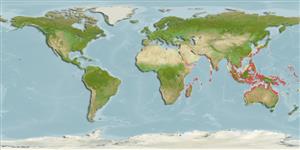Teleostei (teleosts) >
Blenniiformes (Blennies) >
Blenniidae (Combtooth blennies) > Blenniinae
Etymology: Laiphognathus: Greek, laiphos, -eos = rag, tatter + Greek, gnathos = jaw (Ref. 45335).
More on author: Smith.
Environment: milieu / climate zone / depth range / distribution range
Ecology
Marine; reef-associated; depth range 2 - 8 m (Ref. 90102). Tropical
Indo-West Pacific: East Africa south to Inhaca, Mozambique and east to New Guinea and the Solomon Islands, north to Japan (Ref. 37380). Likely to occur in Seychelles (Ref. 1623).
Size / Weight / Age
Maturity: Lm ? range ? - ? cm
Max length : 4.0 cm SL male/unsexed; (Ref. 4404)
Dorsal spines (total): 11 - 12; Dorsal soft rays (total): 18 - 21; Anal spines: 1; Anal soft rays: 19 - 25. Body elongate, compressed. Head small, without crests. Elongated seventh and eight dorsal fin spines and two cirri on the anterior nostril rim (Ref. 37380). Body pale in color with small black spots (Ref. 4404).
Body shape (shape guide): elongated.
Adults inhabit shoreline reefs and sheltered lagoons (Ref. 90102). Oviparous. Eggs are demersal and adhesive (Ref. 205), and are attached to the substrate via a filamentous, adhesive pad or pedestal (Ref. 94114). Larvae are planktonic, often found in shallow, coastal waters (Ref. 94114).
Life cycle and mating behavior
Maturity | Reproduction | Spawning | Eggs | Fecundity | Larvae
Oviparous, distinct pairing (Ref. 205).
Springer, V.G., 1986. Blenniidae. p. 742-755. In M.M. Smith and P.C. Heemstra (eds.) Smiths' sea fishes. Springer-Verlag, Berlin. (Ref. 4404)
IUCN Red List Status (Ref. 130435: Version 2025-1)
Threat to humans
Harmless
Human uses
Fisheries: commercial; aquarium: commercial
Tools
Special reports
Download XML
Internet sources
Estimates based on models
Preferred temperature (Ref.
123201): 24.4 - 29.2, mean 28.5 °C (based on 2567 cells).
Phylogenetic diversity index (Ref.
82804): PD
50 = 0.7500 [Uniqueness, from 0.5 = low to 2.0 = high].
Bayesian length-weight: a=0.00575 (0.00253 - 0.01308), b=3.06 (2.86 - 3.26), in cm total length, based on LWR estimates for this (Sub)family-body shape (Ref.
93245).
Trophic level (Ref.
69278): 3.2 ±0.4 se; based on size and trophs of closest relatives
Resilience (Ref.
120179): High, minimum population doubling time less than 15 months (Preliminary K or Fecundity.).
Fishing Vulnerability (Ref.
59153): Low vulnerability (10 of 100).
🛈
Nutrients (Ref.
124155): Calcium = 298 [144, 584] mg/100g; Iron = 1.16 [0.63, 2.10] mg/100g; Protein = 18.1 [16.8, 19.2] %; Omega3 = 0.0975 [, ] g/100g; Selenium = 20.1 [8.1, 49.3] μg/100g; VitaminA = 158 [43, 565] μg/100g; Zinc = 3.31 [2.03, 4.99] mg/100g (wet weight);
